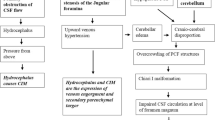Summary.
Patients with Chiari's malformation without myelodysplasia often suffer from another associated spinal cord lesion – syringomyelia. A condition entirely overriding the clinical picture, affecting adversely the results of surgery as well as the prognosis of this congenital developmental defect. Proceeding from the results of their surgical treatment of 40 patients with hindbrain malformation, the authors recommend, in accordance with the literature, a different approach to and classification of patients depending on the presence of syringomyelia (A/B classification; A: syringomyelia on MR – present, B: absent).
The pathological development of the syrinx is caused by obstruction to the natural CSF circulation in the subarachnoid spaces of the craniocervical junction (Williams' dissociation theory). The authors are convinced that routine (static) imaging methods (CT, MR) cannot prove the presence or behaviour of a CSF block, and that they cannot help choose reliably the optimum type of treatment. In contrast, direct measurement (and monitoring) of CSF pressure in different compartments of the CSF pathways (intracranial/intraspinal compartment, i.e., in front of and beyond the suspected block) are a method which can help ascertain with precision the presence and behaviour of a CSF circulatory block, and which also provides dynamic information on such a block during the diurnal rhythm for a period of several days.
The authors present the results of a prospective study of 25 patients with hindbrain malformation and describe a technique of parallel monitoring of the two CSF compartments using an adaptation of the Williams method, as well as two different types of dissociation tests designed to prove the presence of a CSF block. CSF flow obstruction was found in 11 patients, in 14 patients it could not be proved. In 8 out of 9 patients with a fully developed syrinx (group A) the block was found as expected. It was, however, diagnosed also in 3 patients until then whitout any graphic proof of a syrinx (group B). The authors also report on short-term (3-year) results of surgical treatment in patients with rhombencephalic malformation, who had 2 different modes of treatment indicated on the basis of dissociation test results. The advantages and disadvantages are discussed of direct measurement and parallel monitoring of CSF in comparison with radiological methods; emphasis is laid on inevitable radicality in the recanalization of CSF passages in patients with well established CSF blocks.
Similar content being viewed by others
Author information
Authors and Affiliations
Rights and permissions
About this article
Cite this article
Häckel, M., Beneš, V. & Mohapl, M. Simultaneous Cerebral and Spinal Fluid Pressure Recordings in Surgical Indications of the Chiari Malformation without Myelodysplasia. Acta Neurochir (Wien) 143, 909–918 (2001). https://doi.org/10.1007/s007010170021
Issue Date:
DOI: https://doi.org/10.1007/s007010170021




